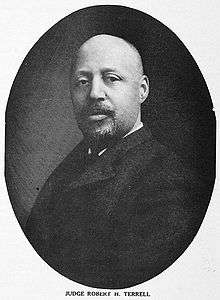Robert Heberton Terrell
| Robert Heberton Terrell | |
|---|---|
 | |
| Born |
November 27, 1857 Orange, Virginia |
| Died | December 20, 1925 (aged 68) |
| Education | Groton Academy |
Robert Heberton Terrell, was the first African American justice of the peace to serve in Washington, DC. He was born in Orange, Virginia on November 27, 1857 to parents Harris and Louisa Ann Terrell.[1][2] Terrell was one of seven Magna Cum Laude scholars to graduate from Harvard University in 1884. He later went on to attend Howard University School of Law.
Biography
Marriage and family
On October 18, 1891, Terrell married Mary Church Terrell. The two met at the Preparatory School for Colored Youth now known as the M Street High School, in Washington, D.C.[3]
Early career
From 1884-1889, Terrell taught at the M Street High School. In 1889, he left the school when he was appointed the chief of division, Office of the Fourth Auditor of the U.S. Treasury Department.[2] In 1896, Terrell began a partnership with John R. Lynch to create the law firm of Lynch and Terrell in Washington D.C. Their firm existed for just about two years and came to a close in the year 1898 when President William McKinley appointed Lynch as "a Major and Paymaster of volunteers to serve as such in the Spanish-American War."[2] In 1899, Terrell was hired as principal of the M. Street High School, a position he left in 1901.[2]
Municipal Court of the District of Columbia
In 1901, Terrell accepted an appointment to serve as a justice of the peace in Washington D.C., which made him the first African-American justice of the peace in Washington D.C.[1] This marked a difficult time for Terrell and other African American leaders during this time because the same government that saw Terrell and other African Americans fit to lead in government did not believe in granting civil rights to all African Americans. In 1910, Terrell was appointed by William Howard Taft to the Municipal Court of the District of Columbia. Terrell was appointed and reappointed by Presidents Taft, Roosevelt, and Wilson.[4]
Howard University Law
Terrell became a faculty member at the Howard University of Law in 1911, while still serving as a municipal judge. In February 1911 he became a charter member of the first Washington D.C. chapter of Sigma Pi Phi fraternity, the oldest African American fraternity in the nation. He remained in this position until his death in 1925.[2]
In 1919, Terrell along with Henry Lassiter, Lafayette M. Hershaw, Archibald Grimké, and Walter J. Singleton was a prime mover in the introduction by Congressman Martin B. Madden of a law (H.R. No. 376) to abolish the "Jim Crow" car.[5] The Madden Amendment to the Esch–Cummins Act failed.
Death
About four years before his death, Terrell suffered from his first stroke. About a year later he had a second stroke, and it was this stroke that left him paralyzed on one side of his body. Regardless of his severe asthma and his declining health, Robert continued to serve as a municipal court judge. In early December 1925, Terrell's asthma and health began to worsen, Terrell later died at his home on December 20, 1925.[1] Robert H. Terrell had an obituary featured in The Crisis, the official magazine of the National Association for the Advancement of Colored People, where he is described as "a good fellow...tall and healthy to look at ; a lover of men, of his social glass, of a good story with a Lincoln tang to it." [6]
In 1931, Howard University Law School closed and in response that same year George A. Parker, Philip W. Thomas, Louis R. Mehlinger, Benjamin Gaskins, Chetser Jarvis, and Hershaw founded the Robert H Terrell Law School named for Terrell.[7]
In 1952, the Robert H. Terrell Junior High School, named in his honor, opened at 100 Pierce Street, NW, Washington, DC.[8] His wife also had a DC school named for her. Terrell Junior High School closed in August 2006, was demolished between November, 2007 and June, 2008 and then replaced by the R. H. Terrell Recreation Center in 2009.
References
- 1 2 3 "Terrell, Robert H.(1857–1925) - Lawyer, judge, Chronology". encyclopedia.jrank.org. Retrieved 2016-05-16.
- 1 2 3 4 5 Terrell, Robert (1954). "Robert H. Terrell Papers (1870-1954)" (PDF). The Library of Congress. Retrieved 2016-05-16.
- ↑ "Terrell, Robert H. (1857-1925) | The Black Past: Remembered and Reclaimed". www.blackpast.org. Retrieved 2016-05-15.
- ↑ Inc, The Crisis Publishing Company (1918-06-01). The Crisis. The Crisis Publishing Company, Inc.
- ↑ "Offers Bill To Abolish The "Jim Crow" Car". Washington Bee (Washington (DC), District of Columbia). Saturday, March 8, 1919 Page: 3
- ↑ Inc, The Crisis Publishing Company (1926-03-01). The Crisis. The Crisis Publishing Company, Inc.
- ↑ "Lafayette McKeene Hershaw". The Journal of Negro History. Vol. 30, No. 4 (Oct., 1945), pp. 462-464
- ↑ "Rep. Diggs Dedicates Terrell Junior High". 25 March 1955. Retrieved 22 June 2016.